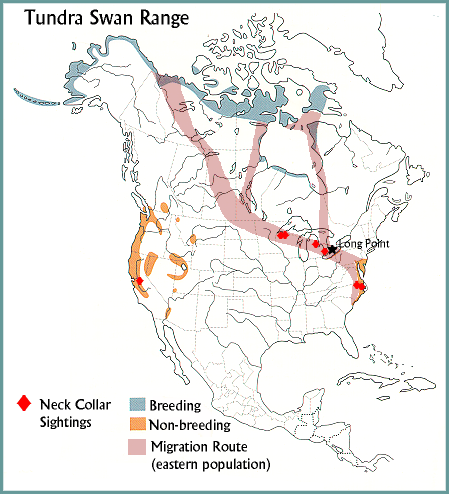

Pairing - The courtship and pairing of young adult birds is in full swing in late winter and continues through the spring migration. Adults already paired reinforce their bond by vocal and visual displays. The most spectacular of these is the so-called victory display in which male and female face each other, extend and wave the wings slowly, bow the head and neck forward and backward, and, in duet, produce a formalized sequence of loud, melodious sounds. The pair-bond is strong and probably lasts for life.
When thousands of birds are concentrated at a migratory staging point, the level of sound is very high, particularly at night when much of the social activity takes place.
Tundra swans begin leaving their winter habitat after the first spring thaw. Tundra swans from Chesapeake Bay cross Pennsylvania to Lake Erie (see... 8.2.4), from the first week in March into early April and provide a striking spectacle when several thousand make a stop near Long Point on Lake Erie (see... Figure 8.52).
Tundra swans at their central California winter grounds also leave in mid-February, and within 3 weeks almost all have departed. By early April most have migrated north to Alaska and Canada. The first swans generally reach their breeding grounds on the Yukon Delta in late April and almost all arrive by mid-May. The western population of tundra swans migrate earlier and more swiftly than its eastern counterpart.
Nesting:
Timing of Nesting Events:
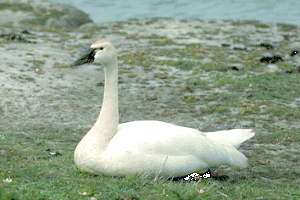
Age at first breeding - Tundra swans first breed when they are 2 or 3 years old. They form lifelong monogamous pairs [10].
Nesting - Tundra swans start nesting in late May to late June depending on location and weather. They usually do not breed until their fourth or fifth year. A year before breeding, pairs normally “go steady” and select and defend a territory without actually nesting. When they reach breeding age, they begin to nest in late May or early June before the snow is off the tundra, while many of the lakes are still frozen.
Clutch size and incubation - The cream-coloured, elliptical-ovate eggs average 107 mm in length. A clutch of four eggs is normal; in exceptionally warm, favourable springs the female often lays five or six eggs. An unusually cold and snowbound spring, on the other hand, may inhibit nesting for that year. Not all adult pairs nest every year. The incubation period is 30 to 32 days and begins when the final egg is laid and lasts about 32 days. Only the female incubates the eggs, but the male remains close by, guarding the nest site and defending the territory. If the eggs are destroyed, renesting will not take place.
Cygnet development and fledging - Tundra swan cygnets are generally able to fly within 9 to 10 weeks. The family remains
The downy ash-gray cygnets emerge in early July and weigh about 180 g. They are soon able to forage for themselves; both parents help them find suitable plant food around the margins of the pond. They need to be brooded frequently, to protect them from the cold and the onslaughts of myriads of mosquitos. The early casualty rate among cygnets is quite high, chiefly due to cold or starvation. If all goes well, the cygnets’ growth rate is very rapid and in September, after about 70 days, their weight may be 28 times the hatching weight. This growth rate is necessary, because by early September the cygnets must be fully feathered and able to fly well enough to travel to larger lakes that will freeze over more slowly and regain flight within 35 to 40 days.The family remains on the territory and together during the fall migration, through winter, and during spring migration.

Molt - On the Yukon Delta, adult tundra swans molt between July and August they are flightless for several weeks, until the moulted primary wing feathers are replaced by new ones. Nonbreeders, which remain in flocks of 3 to 15 during the breeding season, regain flight in late August and begin to congregate in sizable flocks where young, non-breeding birds of the previous year and unsuccessful nesters or unpaired adults that have spent the summer in small groups in favourable feeding locations. From these points, the flocks begin the early stages of migration as freeze-up approaches. An early winter will doom cygnets not yet ready to fly out of the north.
Even after they have returned to the wintering range, birds of the eastern population in the northern part of Chesapeake Bay may face a prolonged freeze in a severe winter. Rather than heading south to more temperate conditions, they sometimes spend most of this time sleeping on the ice, their heads drawn back under their wings. Many birds often die, particularly young birds.
Preferred Breeding Habitat:
- Tundra swans usually breed on or near tundra ponds, lakes, and sluggish rivers, and less often near sheltered tidal waters. They tend to avoid areas near exposed marine coasts.
Nest Sites:
Tundra swans often select islets in tundra ponds and lakes as nest sites they are solitary nesters, and each pair defends a large territory that may be more than 2 square km. Nests are also commonly located on the main shores of lakes or ponds, heath tundras, hummocks in marshes or tidal meadows, or more rarely, level stretches in marsh or meadow areas. The nest is an elaborate platform, a large conical affair of sticks 12 to 18 inches (30-45 cm) high, composed of mosses, grasses, and sedges. It resembles a muskrat house surrounded by a moat. In making the nest, the vegetation is plucked from around the nest site, creating a circle of open water up to 15 feet (4.6 m) in diameter. In optimum habitat, several pairs of swans may have nests very widely spaced but still in view of one another, with room for a loafing area for the young but not too large to defend against other breeding pairs. Nests in favourable locations tend to be re-used each year.
Cover Requirements:
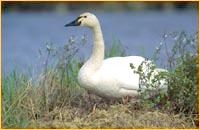
Tall emergent vegetation provides shelter and cover for tundra swans. Adult swans remove vegetation around the nest until the nest is surrounded by open water.
In Canada, the Tundra Swan nests mainly in the northern tundra near the tree line.
The female lays three to five creamy eggs in the nest, which is a mound of moss and grass, is built on the ground, usually 3 feet high and can be seen 2 miles a way.
The Tundra Swan nests in the tundra. Although swans may be seen on ponds and marshy lakes, they may also build nests far from the water. When they are moulting, they are often found on broad stretches of water.
Arctic Bird Connection:
The North Slope of Alaska is about as far north as the Tundra Swan breeds. The length of the summer from ice out to freeze up does not allow for replacement clutches to be laid. Young swans are not able to fly until the first week of September in most years. By that time, many smaller and shallower ponds on the coastal plain are starting to freeze. If the young swans could not fly for another week or two, they would likely succumb to the elements. Even the adults require almost the entire summer to complete most of their own molt (i.e., feather replacement), which leaves them flightless for more than a month.
Fall Migration:
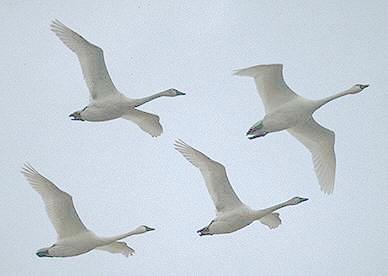
Although some swans may winter in the Great Lakes area, most prefer to leave for the warmer climes of the American Atlantic and Pacific coasts. The eastern fall migration brings the Tundra Swan back through Long Point Country, (see... Figure 8.53), as they fuel-up for that last push toward their final destination on Chesapeake Bay. Known as the largest wintering ground in North America, a migration that takes them approximately 4,200 miles.
Tundra swans migrate in family units, with several families and probably some on breeding birds combining in a single flock. In the West, tundra swans leave major breeding grounds in Alaska in late September and early October. Marshes adjoining the eastern shore of Great Salt Lake begin to receive tundra swans in mid-October. Tundra swans begin arriving at the Malheur National Wildlife Refuge in Oregon from mid- to late November and remain abundant well into December. In the Klamath basins of Oregon and California, wintering tundra swans do not arrive in substantial numbers until late November and early December. On winter grounds adjacent to San Francisco Bay, the swans are not present in great numbers until early December.
The eastern contingent of tundra swans passes across Minnesota, Wisconsin, and Michigan, largely during November 5 to 15. Tundra swans on Chesapeake Bay slowly increase in numbers through December and reach a peak in January. When migrating, they fly at great altitude approximately 2,000 - 4,000 feet. Some will show evidence of severe exhaustion, suggesting forced landings after prolonged and unsuccessful struggles against strong winds. Some of this data can be extracted from band returns Figure 8.1.
Winter Habitat:
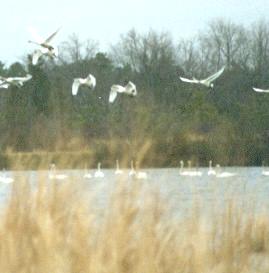
In winter, tundra swans use extensive shallow fresh and brackish water. They are less frequently found on salt water. Migrants occur at ponds, lakes, flooded lowlands, slow-moving streches of rivers, and estuaries.
History:
Archaeological finds show that the Tundra Swan was more widespread in eastern Canada in the 17th century when they appear to have nested along the Ontario and Quebec shores of Hudson's Bay. In the 19th century, the trade in swan skins by the Hudson's Bay Company was a major factor in the decline of the eastern Canadian nesting population. A population increase has been observed since the middle of this century. Today historical changes and impact in waterfowl distribution and abundance for the Tundra Swan are being charted Figure 8.19.

